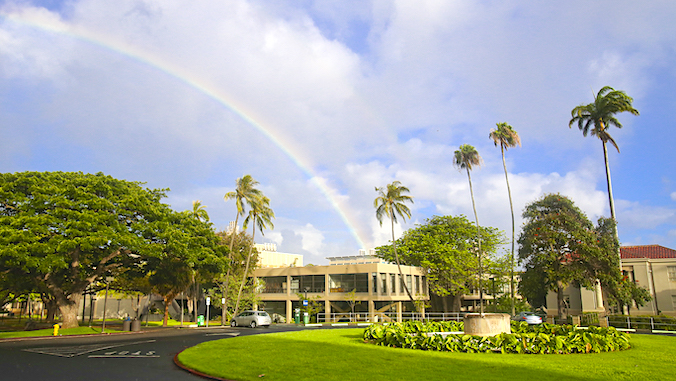
The University of Hawaiʻi is in line to receive tens of millions of dollars in federal funding with the passage of the $1.5-trillion Consolidated Appropriations Act of 2022, which President Joe Biden signed into law on March 15. The federal funding is expected to have an impact across the 10-campus system as it increases student financial assistance, provides millions for research important to Hawaiʻi and funds multiple UH projects and initiatives.
“We are extremely grateful to our Hawaiʻi congressional delegation for their support throughout this lengthy federal appropriations process,” said UH President David Lassner. “This budget provides significant investment in critical programs that support higher education and our students nationally, as well as UH– and Hawaiʻi-specific investments. Our sincere thanks to Sen. (Brian) Schatz and Rep. (Ed) Case, who serve on the Appropriations Committees, as well as Sen. (Mazie) Hirono and Rep. (Kai) Kahele, for all of their hard work to secure these critical investments through their committee work and advocacy.”
Aside from the funding for a wide variety of areas listed below, the Act also included the reauthorization of the Violence Against Women Act (VAWA). VAWA supports comprehensive, cost-effective responses to domestic violence, sexual assault, dating violence and stalking.
Students in need
The act increases funding to support low-income students and Minority Serving Institutions:
- The maximum Pell Grant award was increased by $400, to $6,895, for the 2022–23 academic year, the biggest increase to the Pell maximum in more than a decade.
- $10.9 million for the Strengthening Asian American and Native American Pacific Islander-Serving Institutions program, a $5.8-million increase from federal fiscal year 2021, which runs from October 1 to September 30 (FY21).
- $21.3 million for the Strengthening Alaska Native and Native Hawaiian-Serving Institutions program, a $2.3-million increase from FY21.
- Other federal programs received increases including the Supplemental Educational Opportunity Grant, Federal Work Study, TRIO, GEAR UP and the Graduate Assistance in Areas of National Need programs.
Native Hawaiians

The act increases funding for federal programs that support Native Hawaiians:
- $38.9 million for the Education for Native Hawaiians program, an increase of $1.5 million from FY21.
- $4 million for the U.S. Department of Agriculture’s Education Grants for Alaska Native and Native Hawaiian Institutions program, an increase of $806,000 from FY21.
- A $5-million increase for NASA’s Minority University Research and Education Project, which has been directed to utilize funds to connect science, Indigenous culture and community at minority-serving higher education institutions, including Native Hawaiian-serving institutions.
- A $1 million increase, for a total of $3 million, was provided for the Center for Indigenous Innovation and Health Equity, a partnership between UH, Oklahoma State University and the University of Alaska.
The measure encouraged the Office of the Director in the National Institutes of Health (NIH) to prioritize the research needs of Native Hawaiians and to partner with entities that have a proven record of working closely with Native Hawaiian communities and organizations to allow for the development of NIH researchers.
UH programs
The act includes about $5.5 million in congressionally directed spending for a number of programs:

- $1 million for the UH Hilo ʻImiloa Astronomy Center for the Hale Pōhaku Exhibition and Planetarium Expansion.
- $1 million for Asia-Pacific Microgrid Development and Training through Hawaiʻi Natural Energy Institute, a unit of the UH Mānoa School of Ocean and Earth Science and Technology (SOEST).
- $1 million for a Strategic Center for Indo-Pacific Studies in the UH Mānoa School of Pacific and Asian Studies.
- $1 million for a Rural Health Research Center in the UH System Office of Strategic Health Initiatives.
- $445,000 for Partnerships for Puʻuloa (Pearl Harbor) Shoreline Biocultural Restoration in partnership with the UH System Office of Indigenous Innovation and the UH Mānoa College of Tropical Agriculture and Human Resources’ Department of Natural Resources and Environmental Management.
- $200,000 for the Hawaiʻi Institute of Marine Biology, a unit of UH Mānoa SOEST, for Nature-Based Coral Reef Features for Coastal Protection.
- $900,000 for a new post-harvest processing facility at MAʻO Organic Farms, a UH partner, to provide more locally produced foods in the community while expanding their youth internship program, training and other educational opportunities through UH.
Research
More than $700 million in the act is to address the Red Hill water crisis. As UH has played an important role in the state’s response to the crisis, the university is expected to receive tens of millions over the coming years for related research. That would include a water security and resilience initiative, hydrogeology studies and fuel tank corrosion evaluation and monitoring.
The act also makes strong investments in federal research agencies, all of which benefit UH, including the National Institutes of Health, National Science Foundation, National Aeronautics and Space Administration, National Oceanic and Atmospheric Administration and the National Endowment for the Humanities. The funding for research also includes:
- $40-million increase for the High Performance Computing Modernization Program in the Department of Defense, which includes the UH-managed, Maui High Performance Computing Center.
- $3-million increase for the U.S. Geological Survey Volcano Hazards Program, which provides continuing support to the UH Hilo Center for the Study of Active Volcanoes.
- $7-million increase for the Energy Transitions Initiative, which helps remote and island communities design their own resilience and clean energy solutions.
- $2.5-million increase in the Alternative Energy Research program, which supports the UH Hawaiʻi Natural Energy Institute and climate resiliency work in SOEST.
- $7.5 million for a new program called Resilient Innovative Sustainable Economies via University Partnerships (RISE-UP) that will support a collaboration between universities in isolated and island states with expertise in energy, marine and blue economy technologies to diversify their state economies.
- $1.2 million for coffee leaf rust research.
- $1 million for science-based pest management strategies for invasive insect species that affect tropical grazing lands.

